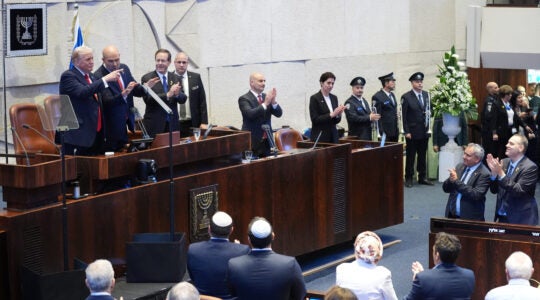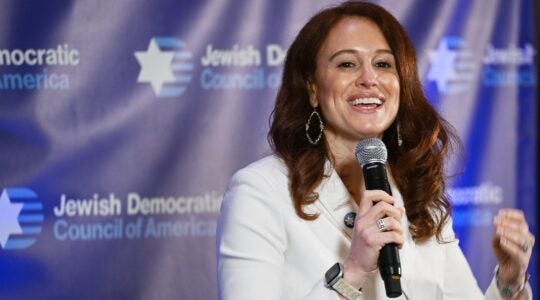The kochelein
The kochelein — a term that literally means “cook alone” — represented a particular kind of bungalow colony: a place where several families shared a house but where everyone was responsible for their own food. That’s why there were half a dozen fridges and ovens in the kitchen: Each of the 10 families was allotted half a refrigerator and a shared oven to prepare meals.
A pharmacist from the Bronx, Nat Goldberg began bringing his family to this kochelein, called Fairhill, in 1953, when Judy was still in diapers and her sister Paula was 5. The rest of the house was filled with cousins and close friends, all from the same working-class Bronx neighborhood. Everybody, of course, was Jewish.
There was practically no privacy: Parents and their children slept in the same room, all the families shared only two bathrooms and everyone ate their meals in the shared dining room.
From a kid’s perspective, the summers were idyllic. Days were spent hiking in the woods, swimming in the lake, picking wild blueberries, playing hide-and-seek, trying to sneak into the resort at Kutsher’s and waging endless girls vs. boys wars. On rainy days they’d pack into the dining room with their parents to play mah-jongg or a variation of rummy, gambling for split peas. After the rain stopped, the kids would run outside to hunt salamanders.
Once the Goldberg kids turned 10, they were allowed to hitchhike into Monticello; their mother would wave goodbye as they climbed into strangers’ cars. On weekends they might catch rides with their father en route to the racetrack.
On Saturday nights, when the adults went out, the kids left to their own devices smoked, played kissing games and did whatever else they could think of that their parents had forbidden.
“Every one of us will tell you it was the best time of our lives,” Paula said of those summers. “Our mothers never knew where we were and didn’t care.”
For the adults, the bungalow colony was both an extension of and a break from their lives in the crowded Jewish enclaves of the Bronx. It was mostly the same people, but there was cleaner air, less privacy and less testosterone: The men, who worked Monday to Friday, came up only on weekends; the women and children stayed all summer.
“It was a total matriarchy,” Paula said.
It was the 1950s, before three major factors destroyed the Jewish Catskills: air conditioning, which made staying in the city more palatable; declining discrimination against Jews, which opened up previously unavailable summertime alternatives; and the rise of the working woman, which made moving away for the summer untenable.
The bungalow colony was not for the wealthy. Accommodations were simple. Water came from a well. When it went dry one summer, the families went days without showering and walked around with divining rods. The swimming pool — now cracked, overgrown and shrouded by trees — wasn’t built until sometime in the late ’50s.

At left, Paula Goldberg with the guy who would one day be her husband, Mark. Her parents, Nat and Sylvia Goldberg, are seen in a 2002 photo. (Courtesy of Paula Goldberg)
With the exception of Nat Goldberg, none of the men at the kochelein had gone to college, and they all worked blue-collar jobs. Jewish families with more money went to resorts like Kutsher’s, where meals, entertainment and a wide range of recreational facilities were included. At Kutsher’s, residents of bungalow colonies like the Fairhill kochelein were referred to derisively as “bungees.”
Entertainment at the kochelein was mostly homemade: Someone would play the piano or the adults would hold silly parties where everyone wore their clothes backward or husbands and wives swapped clothing or held mock weddings or soup-eating contests.
The men were constantly pranking each other. In the mornings, the first thing everyone would do was get in line for the bathroom, toothbrush and soap in hand. With as many as 40 people sharing just two bathrooms, dillydallying was severely frowned upon — not least by your stern, socially conscious mother.
“Everything happened in front of everybody else — all the babying, all the disciplining,” Judy recalled. “There was no private place to yell at anybody.”
One morning when she was 11, Judy had to conceal a hickey she said a boy had forced on her neck the night before.
“It was the summer, you couldn’t wear a scarf,” she said. “So I put on makeup before I came out from the top of my head down to my neck thinking nobody would notice.”
To no avail. As soon as she walked into the dining room, a girl named Arlene spotted it and broke into peals of laughter. Judy was humiliated; her mother made her wear pancake makeup until the hickey subsided.
The food was kosher — to some degree. At home in the Bronx, Sylvia would let her kids have milk after meat, but at the bungalow colony she was stricter because Aunt Faye was sitting at the next table.
“We used to pretend to be kosher,” Judy said. “It was shameful if you weren’t kosher. But people were different degrees of kosher.”
Because the ladies didn’t drive, the mothers would list the groceries they needed in a spiral notebook hanging from a hook in the dining room, and the Polish Catholic family that owned the property — Alex and Mary Chicko — would go to town every day to buy the provisions, adding a penny or two to each item as a delivery fee.
The families all shared a single public telephone. If Milton should phone from the city to speak to his wife who was down by the lake, whoever answered would get on the P.A. system and make the announcement, summoning Norma to the receiver.
If the kids misbehaved, the parents would punish them by dragging them along to Kutsher’s shows instead of leaving them behind with their boyfriends and girlfriends.
For Paula, one kochelein relationship proved to have special staying power: with Mark Goldberg, a boy whose family had been coming to the Fairhill kochelein since the 1920s. She was 5 and he was 6 when they met, and they began “going together” in the summer of 1959.
That was when 13-year-old Mark asked Paula to a movie theater in town to see “Journey to the Center of the Earth,” and the two kissed during the film — with their eyes open, Paula says.
He was fresh; he was a bad boy,” Paula said with a mischievous smile.
The two broke up at the end of every summer and then got back together the following July. Some summers Mark’s family didn’t go up to the mountains, but Mark always came — even if it was in the care of someone else’s parents. That is, until the summer of ’66, when Mark’s father collapsed at the kochelein of a heart attack and died. Mark was 19.
When Mark was 22 and Paula was 21, they married. The couple recently celebrated their 45th wedding anniversary.
JTA has documented Jewish history in real-time for over a century. Keep our journalism strong by joining us in supporting independent, award-winning reporting.






